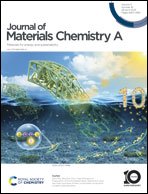An interconnected silicon–carbon conductive framework for dissipating mechanical strain for advanced Li-ion storage†
Abstract
The ultra-high capacity of silicon (Si) holds great promise for high-energy density Li-ion batteries. Unfortunately, effective dissipation of the mechanical stress of Si while improving conductivity remains a great challenge. Here, Si@SiOx nanoparticles (NPs) and polyvinyl alcohol were uniformly and effectively combined by the molecular self-assembly strategy. Using (NH4)2S2O3 as a foaming agent, freeze drying and in situ carbonization were employed to encapsulate the Si@SiOx NPs into a porous interconnected three-dimensional carbon framework (FNS-Si@C). This structure simultaneously provides ideal mechanical strength, expansion buffer space and fast conductive connection to ensure the stability of the electrode and excellent reaction kinetics. The FNS-Si@C anode with high Si content (74 wt%) exhibited gratifying Li-ion reaction kinetics (1217 mA h g−1 at 1000 mA g−1), impressive cycling stability (678 mA h g−1 after 650 cycles with 99.6% coulombic efficiency at 1000 mA g−1) and favorable structural integrity (44.6% electrode expansion). Furthermore, the assembled full cell coupled with an LiFePO4 cathode delivered outstanding Li-ion storage properties. This strategy of introducing Si into a solid skeleton with good conductivity and mechanical properties can also enhance the electrochemical performance of other alloy-type materials.

- This article is part of the themed collection: 2023 Journal of Materials Chemistry A HOT Papers


 Please wait while we load your content...
Please wait while we load your content...